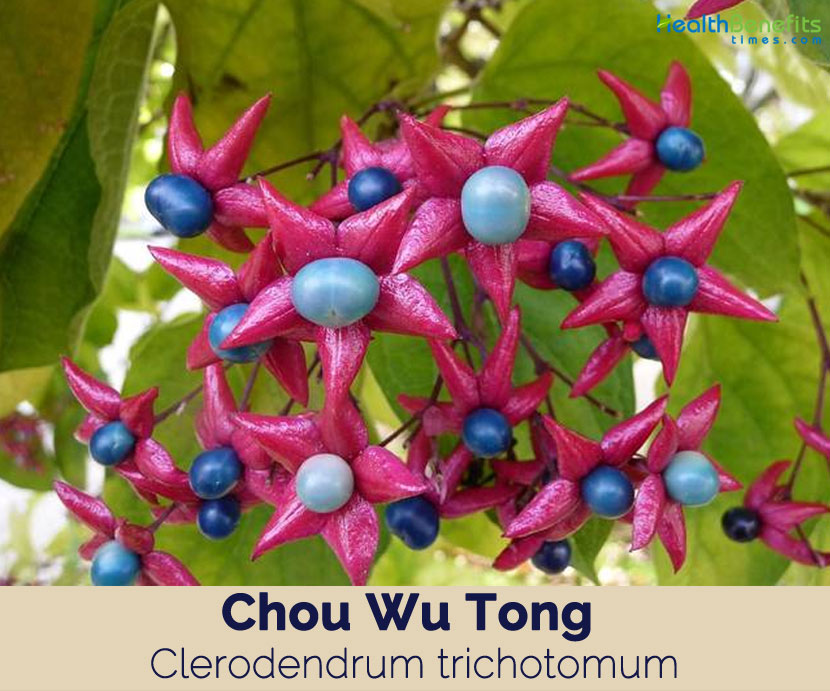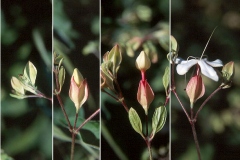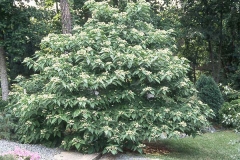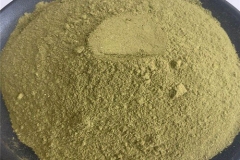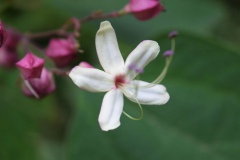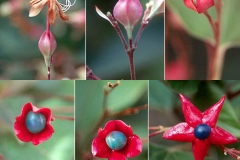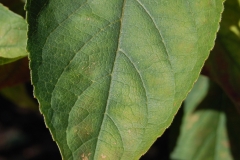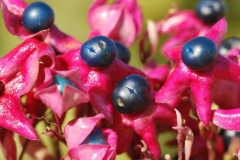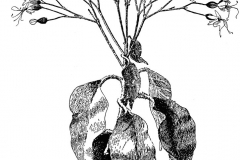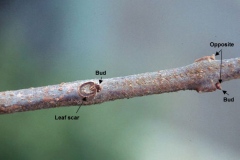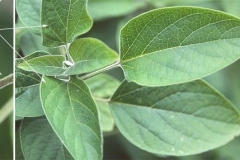| Chou Wu Tong Quick Facts | |
|---|---|
| Name: | Chou Wu Tong |
| Scientific Name: | Clerodendrum trichotomum |
| Origin | China, Taiwan, Japan, Korea, India and the Philippines |
| Colors | Initially white, but become bright blue and then dark blue as they mature |
| Shapes | Pea sized berry like fruit surrounded by the persistent star shaped crimson calyx |
| Taste | Acrid, bitter, sweet, astringent |
| Health benefits | Good for dermatitis, hypertension, rheumatoid arthritis, joint pain, numbness, paralysis and eczema |
| Name | Chou Wu Tong |
|---|---|
| Scientific Name | Clerodendrum trichotomum |
| Native | China, Korea, Taiwan, Japan, India, and the Philippines |
| Common Names | Chou Wu Tong, Harlequin glorybower, Ferruginous clerodendrum, Harlequin Glory Bower, chance tree, Hardy Clerodendrum, Tree-of-Bad-Fortune, Tree-of-Good-Fortune, Japanese clerodendrum, Peanut butter shrub |
| Name in Other Languages | Chinese: Hai zhou chang shan (海州常山), Shān zhū jiā (山豬枷), Chou Wu Tong Danish: Almindelig Skæbnetræ English: Glorytree, Harlequin glorybower , Ferruginous clerodendrum, ferruginous clerodendrum, glory bower Finnish: Isokohtalonköynnös, Isokohtalonpensas French: Arbre du clergé, arbre de la chance German: Japanischer Losbaum, chinesischer Losbaum, kurzborstiger Losbaum Japanese: Kusagi (クサギ) Korean: Nu li jang na mu (누리장나무) Manipuri: Bp-mana Portuguese: Clerodendro-do-Japão Russian: klerodendrum trizhdy vetvyashchiysya (клеродендрум триждыветвящийся), klerodendrum trokhvil’chatyy (клеродендрум трёхвильчатый), klerodendrum trokhrazdel’nyy (клеродендрум трёхраздельный) Swedish: Frilandsklerodendrum Turkish: Kısmet ağacı |
| Plant Growth Habit | Large, deciduous or evergreen shrubs or small trees |
| Growing Climates | Thickets on mountain slopes, throughout most of China |
| Soil | Thickets on mountain slopes, throughout most of China |
| Plant Size | 3–6 meters (10–20 ft.) tall and may reach 7 m in height in nature |
| Bark | Grey and smooth with many lenticels |
| Leaf | Leaves are variable in size, and considerably larger on young plants than on adult ones. They are ovate or oval, 10-23 cm long and 5-10 cm wide |
| Flowering season | August to October |
| Flower | Fragrant flowers are borne on branching peduncles. They have white petals, held within a green calyx which turns red as the fruits ripen |
| Fruit Shape & Size | pea sized berry like fruit surrounded by the persistent star shaped crimson calyx |
| Fruit Color | Initially white, but become bright blue and then dark blue as they mature |
| Propagation | By root cuttings or semi-hardwood cuttings |
| Flavor/Aroma | Off-flavor in smell |
| Taste | Acrid, bitter, sweet, astringent |
| Plant Parts Used | Leaves |
| Culinary Uses |
|
Plant Description
Chou Wu Tong is a large, deciduous or evergreen shrubs or small trees that normally grows about 3–6 meters (10–20 ft.) tall and may reach 7 m in height in nature. The plant is found growing in thickets on mountain slopes, throughout most of China. The plant prefers a fertile humus-rich well-drained loam. The soil must not be allowed to dry out in the growing season. It is most often seen as a suckering shrub. It must be trained to grow as a tree and is rarely seen growing in that form. As an ornamental, this shrub is perhaps best noted for its late summer flowers, showy fruit and foul-smelling foliage. Bark of the plant is grey and smooth with many lenticels.
Leaves
The leaves are situated opposite on the shoots. Leaves are variable in size, and considerably larger on young plants than on adult ones. They are ovate or oval, 10-23 cm long and 5-10 cm wide, occasionally toothed, soft, with scattered down beneath, and flaccid. Stalks are downy, 1 to 4 in. long. The lower leaves are sometimes deeply two or three lobed towards the apex. The upper surface of the leaf is deep green with some bristly hairs and the lower surface is lighter green with hairs especially on the veins. When bruised, the leaves do produce a unique aroma reminiscent of peanut butter as memorialized by the sometimes used common name of peanut butter tree for this plant.
| Leaf arrangement | Opposite/sub opposite |
| Leaf type | Simple |
| Leaf margin | Entire |
| Leaf shape | Elliptic (oval), ovate |
| Leaf venation | Pinnate |
| Leaf type and persistence | Deciduous |
| Leaf blade length | 4 to 8 inches, 8 to 12 inches |
| Leaf color | Green |
| Fall color | No color change |
| Fall characteristic | Not showy |
Flower
Flowers are fragrant, produced from July to September in long-stalked cymes from the axils of the uppermost leaves, the whole forming an erect inflorescence 6 to 9 in. across. The corolla is white, 1 to 11⁄2 in. across, deeply 5 lobed with a rather long corolla tube, and long stamens and styles that project out of the flower some distance. Calyx is reddish, 1⁄2 in. long, inflated, five-angled, and five-lobed. The flowers are strongly fragrant and are reported to attract butterflies and moths. Flowering occurs over an extended period from and can occur simultaneously with ripening fruit.
| Flower color | Red |
| Flower characteristics | Showy |
Fruits
Fertile flowers are followed by pea sized berry like fruit surrounded by the persistent star shaped crimson calyx whose lobes have become fleshy and spreading. They are initially white, but become bright blue and then dark blue as they mature. The color is due to the presence of a unique blue pigment, named trichtomine after the plant
| Fruit shape | Round |
| Fruit length | Less than .5 inch |
| Fruit covering | Fleshy |
| Fruit color | Blue |
| Fruit characteristics | Does not attract wildlife; not showy; fruit/leaves not a litter problem |
Traditional uses and benefits of Chou Wu Tong
- Leaves are mildly analgesic, antipruritic, hypotensive and sedative.
- They are used externally in the treatment of dermatitis and internally for the treatment of hypertension, rheumatoid arthritis, joint pain, numbness and paralysis.
- The plant is normally used in conjunction with Bidens bipinnata.
- When used with the herb Siegesbeckia pubescens it is anti-inflammatory.
- Roots and leaves are anti-rheumatic and hypotensive.
- Decoction is used in the treatment of rheumatoid arthritis and hypertension.
- The pounded seed is used to kill lice.
- In Chinese herbal medicine, chou wu tong is recommended for joint pain, numbness, and paralysis, and occasionally for eczema.
- Traditionally regarded as a plant that “dispels wind dampness,” it is now also being used to help lower blood pressure.
- The plant is mildly analgesic and, when used with the herb Siegesbeckia pubescens, is anti-inflammatory.
- This species also known as a medicine-plant which has a proven ability to lower blood pressure.
Other facts
- The leaves have a heavy unpleasant odor when crushed.
- The wood has been used to make clogs and the berries to make dyes.
- It’s beautiful and fragrant white flowers are highly attractive to butterflies, honeybees, hummingbirds, and many other pollinators.
References:
https://www.itis.gov/servlet/SingleRpt/SingleRpt?search_topic=TSN&search_value=501588#null
https://pfaf.org/user/Plant.aspx?LatinName=Clerodendrum+trichotomum
https://plants.usda.gov/core/profile?symbol=CLTR
https://en.wikipedia.org/wiki/Clerodendrum_trichotomum
https://edis.ifas.ufl.edu/st171
http://www.theplantlist.org/tpl1.1/record/kew-43122
https://treesandshrubsonline.org/articles/clerodendrum/clerodendrum-trichotomum/
http://tropical.theferns.info/viewtropical.php?id=Clerodendrum+trichotomum
https://npgsweb.ars-grin.gov/gringlobal/taxonomydetail.aspx?194
https://gd.eppo.int/taxon/CLZTR
https://davesgarden.com/guides/pf/go/772/#b


